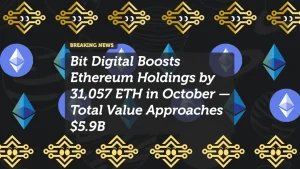
ETH Crashes Below $3,000: Is the Ethereum Bull Market Over?
Ethereum (ETH) has broken below the critical $3,000 support level, sinking to its lowest price in four months and igniting fresh fears across the crypto market.
After weeks of steady declines following failed attempts to reclaim the $3,500–$3,800 zone, ETH’s downtrend intensified as the broader crypto market saw billions wiped out by liquidations and panic selling.
The big question now:
Is the Ethereum bull market officially over — or is this just a deep correction within a larger uptrend?
Let’s break down the drivers behind the drop, the danger signs, and what comes next.
Why ETH Crashed Below $3,000
Ethereum’s decline isn’t happening in isolation — it’s the result of several mounting pressures hitting at once.
1. Massive Market-Wide Liquidations
Crypto markets saw over $19 billion in liquidations following macro shocks, including tariff announcements and a sudden spike in U.S. bond yields.
ETH long positions were among the hardest hit.
2. Ethereum-Specific Bear Pressure
Several ETH-specific factors contributed to the sell-off:
- ETF outflows accelerated as BTC volatility spread to altcoins
- Staking yields dipped, reducing passive demand
- Gas activity cooled, signaling weaker network usage
- Whale outflows to exchanges increased — a classic pre-selloff indicator
3. Market Fear & Rotation to Bitcoin
Investors rotated from altcoins into Bitcoin during the correction. ETH/BTC dropped to a multi-week low, reflecting reduced relative strength — another bearish signal.
Is the Bull Market Really Over?
Despite the violent drop below $3,000, analysts are divided.
Bear Case: Momentum Signals Breakdown
Bears argue the following:
- ETH broke the 200-day EMA
- The $3,000–$3,200 accumulation zone has failed
- RSI has broken trend support
- Open interest is collapsing
To them, $2,400–$2,600 is the next logical target.
Bull Case: This Is a Flush-out, Not the End
Many analysts say ETH is undergoing a deep but healthy correction:
- Long-term holders are not selling
- ETF flows historically lag behind Bitcoin
- Network fundamentals remain strong
- ETH tends to bottom earlier than alts during liquidations
They argue that ETH may be close to a capitulation bottom — a price zone that often precedes major rallies.
Key Levels to Watch
Support Zones
- $2,850 – current test zone
- $2,600 – strong historical support
- $2,400 – macro bullish invalidation
Resistance Zones
- $3,150 – recovery threshold
- $3,500 – momentum shift zone
- $3,800 – breakout level for trend continuation
Ethereum can drop further without invalidating the long-term bull cycle — but losing $2,400 would be a real danger sign.
What Happens Next? Analyst Outlook
Most market analysts expect:
Scenario A: One Final Capitulation Wick
ETH drops to $2,600–$2,700, liquidates late bulls, and then rallies aggressively.
Scenario B: Slow Grind & Reaccumulation
ETH stabilizes above $2,800 and trades sideways while Bitcoin finds direction.
Scenario C: Macro Shock Sends ETH Below $2,400
This would confirm the end of the current bull cycle, though analysts currently view this as less likely.
Final Thoughts: Fear Is High — But Opportunity May Be Close
Ethereum breaking below $3,000 is undeniably bearish in the short term. The level carried psychological and technical weight, and its failure triggered widespread panic.
But historically, ETH bottoms when fear peaks, and corrections of 30–40% are common — even in powerful bull markets.
Until ETH loses long-term macro support around $2,400, the bull market is wounded, but not dead.
















